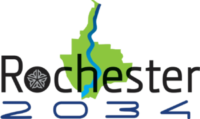SUSTAINING GREEN + ACTIVE SYSTEMS

Natural Resources
The natural environment is a fundamental component of a community’s health and well-being. Rochester is fortunate to have an abundance of beautiful natural resources, from our waterways that give us miles of coastline, to our urban forest integrated throughout the city landscape, to the clean air that we breathe, to the diversity of wildlife that contribute to our ecosystem. Recognizing and appreciating Rochester’s environmental assets is important not only to create a beautiful city, but to ensure the well-being of the people who work and live here.

Parks, Recreation, + Open Space
Parks, and the recreation facilities and services that support their use, are an essential public good – as important to the success of any city as water, sewer, or public safety. Some have called parks the “soul” of a city, arguing that what you see in city parks and public spaces reflects something deep about the character and values of its leadership and investments. Rochester is in elite company in this regard – visionary planning and investment by community leaders more than a century ago endowed us with one of the most unique and extensive urban parks and recreation systems in the country.

Climate Change Mitigation + Adaptation
Climate change is being caused by the excessive build-up of greenhouse gas emissions (GHGs) in the Earth’s atmosphere and is one of the most critical challenges facing our world today. While Upstate New York will not experience some of the most visible negative impacts of climate change like rising sea levels and increased precipitation, more extreme weather events and storms, and even climate refugees.
Rochester’s work to reduce GHGs, assess vulnerabilities, and plan for resiliency is advancing the city toward long-term sustainability.

Urban Agriculture + Community Gardens
Urban agriculture is the practice of cultivating and distributing food in a city. This source of food production in the urban setting is helping to meet growing demand for local food in cities all over the country and in the City of Rochester. Urban agriculture practices include community gardens, urban farms, bee keeping, raising farm animals (chickens, goats, etc.), hydroponics (growing food without soil), and aquaponics (raising fish). Urban agriculture operations can range from large industrial-scale hydroponic operations to a small community garden on an individual vacant city lot. Each practice comes with unique land or facility requirements and cities must determine where and under what conditions these practices will be conducted in the city and to what scale.

Transportation
The demand for a diverse selection of transportation options is growing, and the City of Rochester is striving to meet that demand. What was once a car-first mentality is slowly, but noticeably, shifting to a car-optional one. From its emphasis on Complete Streets that embrace bicyclists, pedestrians, and transit users, to its commitment to launch and expand shared mobility services, the City recognizes the importance of a robust multi-modal transportation system to the quality of life and economic competitiveness of this community.
